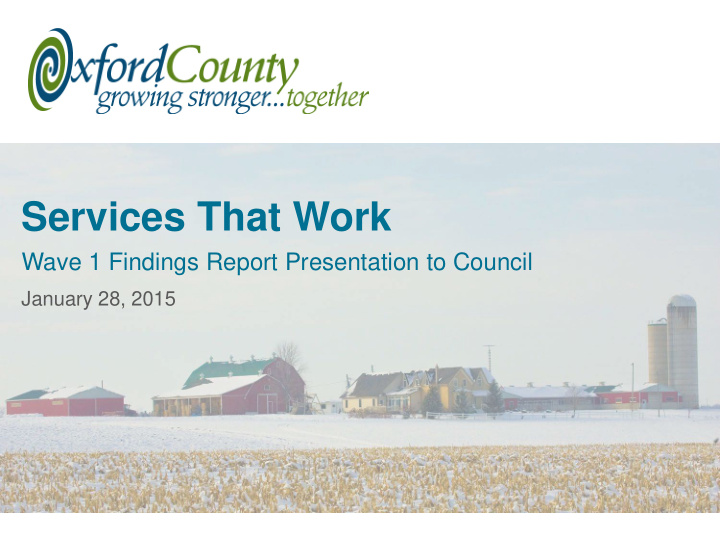



Services That Work Wave 1 Findings Report Presentation to Council January 28, 2015
Introduction • 2014 Business Plan and Budget proposal to undertake service delivery review • Wave 1 services reviewed in 2014 – total of 24 services • Archives • Human Services • Library • Public Health and Emergency Services • Interim Services That Work report received July 9, 2014 • Wave 1 Findings Report contains • Service profiles and highlights • Service financial allocations and insights • Results Based Accountability performance indicators • Service improvement opportunities (SIO) 2
Consultant Presentation: Wave 1 Findings Report
Services That Work Wave 1 Report January 28, 2015 4
Services That Work Mandate • A review of the effectiveness , efficiency , and value of each service provided by the County • Recommendations for changes in services, programs and resources, including whether specific services should be expanded, reduced, discontinued or delivered in an alternate manner 5
Methodology Review • Create a Service Inventory for all County of Oxford services to be used in all waves (Appendix A) • Identify key financial and performance information for services in Wave 1(Appendices B and C) • Identify appropriate peers to review and interview for best practices and benchmarks • Identify potential service improvement opportunities that support improved outcomes and efficiency (Appendix D) 6
Mandatory or Discretionary? • Mandatory – Must be delivered by County as legislated by higher level of government, e.g., Financial Assistance (Ontario Works) • Discretionary – May be delivered by County at own discretion, e.g., Tourism • Traditional – Discretionary service delivered by most or all peer municipalities, e.g., Library Collections • Essential – Discretionary service required to support other services, e.g., Audit 7
Wave 1 Services 8
Human Services • Financial Assistance • Child Care Subsidy • Community Capacity Subsidy • Shelter (Direct Delivered) • Shelter (Subsidy) 9
Public Health & Emergency Services • Building Health Partnerships • Case and Outbreak Management • Health Advocacy and Promotion • Health Monitoring and Surveillance • Health Resource Distribution • Health Protection Certification • Individual Health Assessment and Intervention • Inspections, Investigations and Enforcement • Emergency Management • EMS • 911 Call Taking 10
Library • Library Collections and Resources • Library Programming • Library Public Space Access • Library Information Technology Access • Library Reference and Information 11
Archives • Archives Outreach and Programming • Archives Collections and Resources Management • Archives Reference and Information 12
Services by 2014 Net Impact on the Oxford County Levy Mandatory Red, Discretionary/Traditional Green Insights Sum of • Wave 1 services total net value: Discretionary Services $19.0M 17% • Discretionary and Traditional services: $3.2M or about 17% • Efficiency and effectiveness can be found through a variety of options. Discretionary services may be Sum of eliminated or cut; any service may Mandatory Services reduce service levels or improve 83% efficiency or productivity. • Where efficiencies are achieved, they may be taken as savings or reinvested to improve capacity or Funding formula percentage other services. analysis still in process. 13
Services by 2014 Net Impact on the Oxford County Levy Mandatory Red, Discretionary/Traditional Green Insights Sum of Archives 9% • Wave One Discretionary and Traditional services: $3.2M Archives services only: $280K or 9% • • Efficiency and effectiveness can be found through a variety of options. Discretionary services may be eliminated or cut; any service may Sum of reduce service levels or improve Library 91% efficiency or productivity. • Where efficiencies are achieved, they may be taken as savings or reinvested to improve capacity or Funding formula percentage other services. analysis still in process. 14
Impact on Levy by Mandatory and Discretionary Status 15
Impact on Levy by Mandatory and Discretionary Status 16
Service Improvement Themes Streamline services to families and children: “No wrong door” for vulnerable clients whether coming in for financial assistance, child care, housing, or individual health assessment and intervention by intentionally coordinating service delivery Place community services where people live by co-locating allied services and using Libraries as community service hubs where appropriate Improve the productivity of services that visit families (and businesses) and provide additional hours of services to support working families Maintain access to Library services in small communities by expanding the use of the facilities Focus service outcome efforts on shared definition of quality of life using Social Determinants of Health and Canadian Index of Well-being to plan and deliver services Overall potential for savings, productivity improvements and reinvestment ranges from $500,000 to $1.5M achieved over 3-4 years. Efficiencies will be tracked by project and reported starting in the 2016 Budget. 17
Significant Service Improvement Opportunities Client Efficiency Service Improvement Opportunity Service Transformation to Full Integration of Services Supporting Families, Children and Singles Process and Productivity Improvements for Public Health Public Health Nurses and Inspectors Scheduling, Process and Decentralization Strategy After Hours Public Health Services Reimagine Libraries as Community Hubs Merger of Records Management and Archives 18
Next Steps
Next Steps • Plan and conduct stakeholder consultation • Finish analysis of service improvement opportunities • Review analysis results • Prepare and present recommendations Council 20
Questions?
Recommend
More recommend